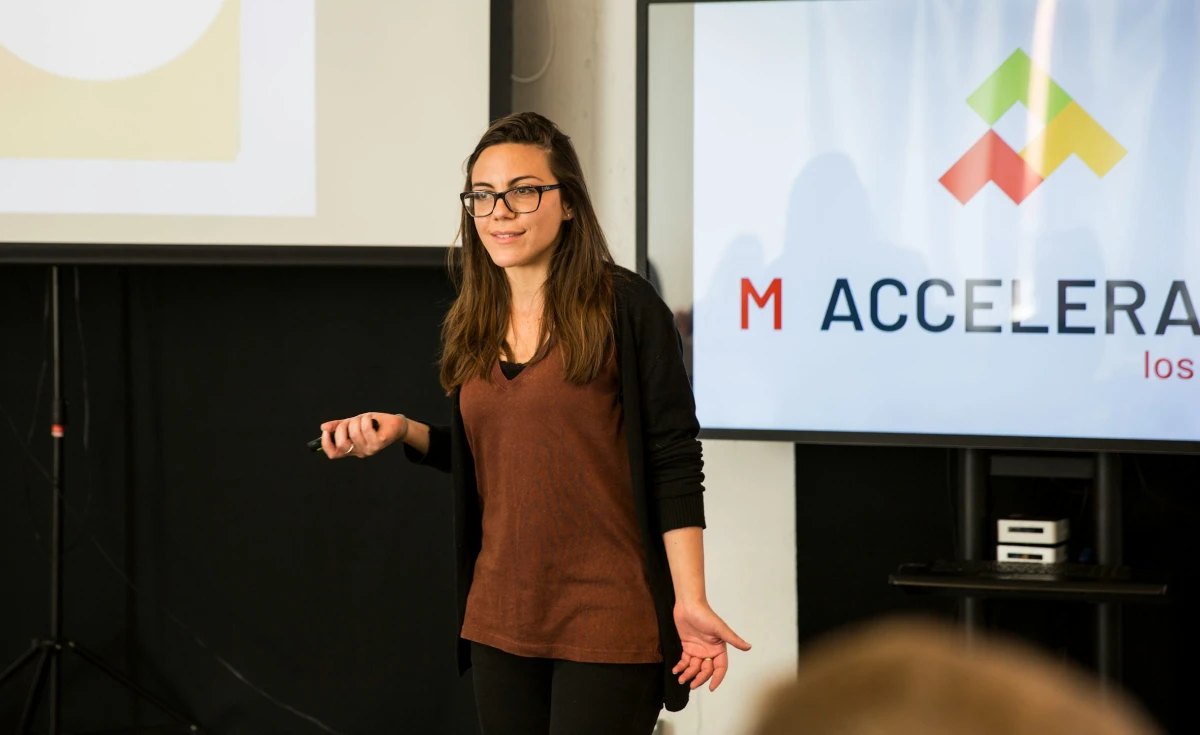finding design software annoyingly difficult to learn, let alone put into practice.
But before diving into the story of Canva, if you’re not familiar with it, do not worry, we are here to keep you up to date. Canva is a graphic design platform that allows users to generate a wide range of designs, such as social media graphics, presentations, posters, and flyers.
One of the finest features of Canva is the abundance of templates, photos, fonts, and graphics available for use in creating your own designs. You don't have to be an expert designer to create something spectacular! The best thing is that you can use Canva on your PC or even your phone to design from anywhere.
Now, taking it back to the story. Melanie Perkins, the co-founder of Canva, recognized the issue that users had with applications such as Adobe Photoshop or InDesign wasn’t that they were having trouble understanding the software. Instead, the software itself represented the problem.
This realization came while she was teaching a design course at the University of Western Australia at the beginning of the 2000s. She even explained that rather than actually diving into the creative process, students spent a whole semester simply figuring out where the buttons were and where to find a particular tool.
That’s when Perkins and her co-founder, Cliff Obrecht, decided to take matters into their own hands!
However, they didn’t start big with a software design from the beginning. On the contrary! They concentrated their efforts on an extremely niche market so they could test their idea – high school yearbooks.
You might wonder why such a random field. But the answer is simple – her mother was a high school teacher. And she was aware of the time and effort her mom had invested in creating each yearbook. So they developed software that allowed both teachers and students to design their own, making the process of creating yearbooks easier than ever.
So when they realized that their idea was promising, that’s when they decided to expand their business! As a result, yearly, they started adding even more books to their portfolio. First 16, then 50, and then even 100. But because of this, they were starting to make waves in Australia (pun intended) and in the business world.
Subscribe to our newsletter
That’s when they met Bill Tai, the investor who would change the course of their business and their lives, for that matter
But what made the whole process challenging for Perkins and Obrecht was that they had no Silicon Valley connections and no knowledge regarding how the business industry works. Perkins wasn’t even using an iPhone yet! She was just a college student with a big idea – but an idea that would soon revolutionize the design world.
Because Bill Tai was intrigued by her idea, he started introducing her to even more people. The co-founder of Google Maps and Google Wave, Lars Rasmussen, took a special interest in Canva, becoming the company’s first advisor immediately.
Because their limited knowledge of creating a business wasn’t enough of an issue, they didn’t even have technical skills. In fact, they didn’t even know how to code! However, to secure funding, they would have needed another co-founder with expertise in this area. Actually, Bill Tai even promised them that he would invest if they found a tech co-founder that was meeting Lars’ standards. But it took them a few years before shaking hands with Cameron Adams, who would become their tech co-founder.
But even while they were searching for a technical co-founder, their journey to finding other investors continued. In fact, they even pitched Canva to the Mai Tai conference. The good news was that their idea received a lot of attention. However, the bad news was that no one was willing to invest. They even held their first fundraising event to secure some capital.
Unfortunately, Canva received a lot of rejections. But they were able to turn their luck around and secure a $3 million investment!
They believed in their idea. So they decided to keep hoping and innovating despite the spate of rejections.
And in 2012, when they were finally able to secure $1.6 million from venture capital firms – such as InnerWest Partners, Blackbird, and Matrix, as well as angel investors like Bill and Lars, Canva was officially born. Their total capital increased to $3 million thanks to a $1.4 million grant they could also secure from the Australian government.
Unsurprisingly, Canva soared to success in no time! At the end of 2021, 100 million people were using Canva, and the company reached over $1 billion in revenue - making it a Unicorn.
Canva’s story is a testament to how hard work and determination can pay off! This shows that you can still attain your dreams even when you lack the necessary resources or skills!
That’s when Perkins and her co-founder, Cliff Obrecht, decided to take matters into their own hands!
However, they didn’t start big with a software design from the beginning. On the contrary! They concentrated their efforts on an extremely niche market so they could test their idea – high school yearbooks.
You might wonder why such a random field. But the answer is simple – her mother was a high school teacher. And she was aware of the time and effort her mom had invested in creating each yearbook. So they developed software that allowed both teachers and students to design their own, making the process of creating yearbooks easier than ever.
So when they realized that their idea was promising, that’s when they decided to expand their business! As a result, yearly, they started adding even more books to their portfolio. First 16, then 50, and then even 100. But because of this, they were starting to make waves in Australia (pun intended) and in the business world.
Subscribe to our newsletter
That’s when they met Bill Tai, the investor who would change the course of their business and their lives, for that matter
But what made the whole process challenging for Perkins and Obrecht was that they had no Silicon Valley connections and no knowledge regarding how the business industry works. Perkins wasn’t even using an iPhone yet! She was just a college student with a big idea – but an idea that would soon revolutionize the design world.
Because Bill Tai was intrigued by her idea, he started introducing her to even more people. The co-founder of Google Maps and Google Wave, Lars Rasmussen, took a special interest in Canva, becoming the company’s first advisor immediately.
Because their limited knowledge of creating a business wasn’t enough of an issue, they didn’t even have technical skills. In fact, they didn’t even know how to code! However, to secure funding, they would have needed another co-founder with expertise in this area. Actually, Bill Tai even promised them that he would invest if they found a tech co-founder that was meeting Lars’ standards. But it took them a few years before shaking hands with Cameron Adams, who would become their tech co-founder.
But even while they were searching for a technical co-founder, their journey to finding other investors continued. In fact, they even pitched Canva to the Mai Tai conference. The good news was that their idea received a lot of attention. However, the bad news was that no one was willing to invest. They even held their first fundraising event to secure some capital.
Unfortunately, Canva received a lot of rejections. But they were able to turn their luck around and secure a $3 million investment!
They believed in their idea. So they decided to keep hoping and innovating despite the spate of rejections.
And in 2012, when they were finally able to secure $1.6 million from venture capital firms – such as InnerWest Partners, Blackbird, and Matrix, as well as angel investors like Bill and Lars, Canva was officially born. Their total capital increased to $3 million thanks to a $1.4 million grant they could also secure from the Australian government.
Unsurprisingly, Canva soared to success in no time! At the end of 2021, 100 million people were using Canva, and the company reached over $1 billion in revenue - making it a Unicorn.
Canva’s story is a testament to how hard work and determination can pay off! This shows that you can still attain your dreams even when you lack the necessary resources or skills!




.webp)











